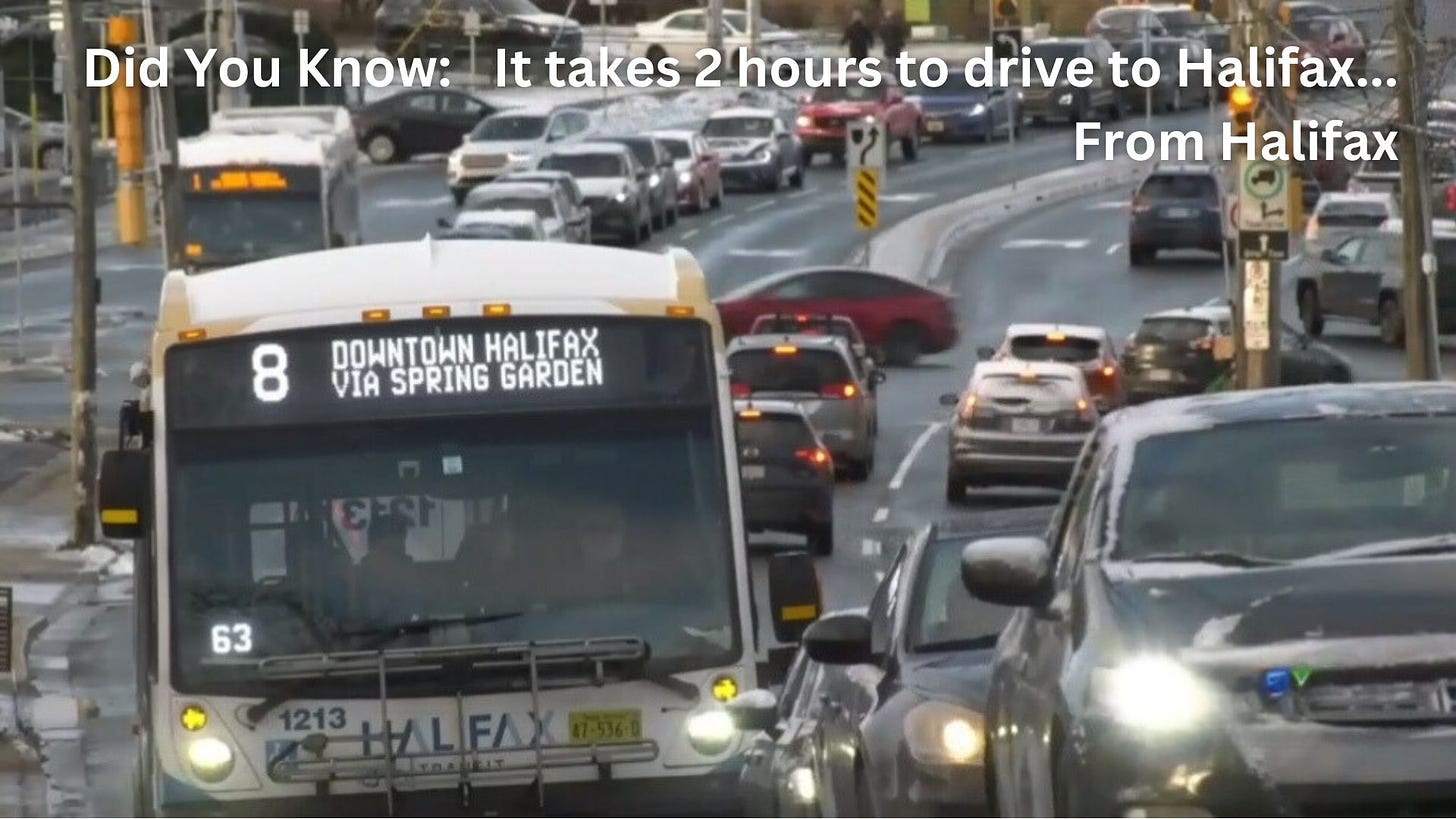Growth!
That’s the plan.
Urban and Up is the direction.
Ten years ago Halifax bet it all on Growth.
Today economists around the world are rethinking growth and the newly pervasive problem of growth without prosperity. It’s not just an uneasy feeling you have. Each of us IS worse off than we were ten years ago in spite of, and maybe because of, growth. I’ve been writing about the problem here.
Halifax is a city at a crossroads. The charm that once defined our streets is being eroded by a combination of too rapid growth, an apparent hatred of beauty, out-of-control bureaucracy, and what can only be described as bad planning. Residents are frustrated, and with good reason. From the ill-timed closure of major intersections to the unseemly big-boxification of our city, it's clear that our city planning is in disarray.
The recent social media uproar over the closure of Oxford and Jubilee during Dalhousie's move-in weekend is just one example of the broader problem. It's not just the inconvenience—it's the sense that those responsible for planning our city are out of touch with the realities faced by those who live here. Off the peninsula, the dozen or so communities dragged into the municipal amalgamation can only look on in wild wonder, effectively ungoverned, without representation, and getting almost nothing back for their taxes.
The Need for Accountability
This lack of foresight points to a deeper issue: the absence of direct responsibility and accountability in our city planning processes. The very concept of responsibility has been replaced by a fear-driven carnival of ‘public engagement sessions’ and hipster rap session ‘knowledge cafes’ that at best break down responsibility into small forgettable pieces, and at worst just provide cover for any presupposed hare-brained scheme. This is not just a bureaucratic oversight—it's a failure of governance that affects the daily lives of everyone in the city for generations to come.
As taxpayers, we are funding an $18 million-a-year Chief Administrative Officer (CAO) office (see the post: Hey, Who’s Running This Town anyway!) that seems unwilling or unable to take responsibility for these decisions. The result? Departments and bureaucrats run wild, making decisions that are neither accountable nor transparent.
A Misguided Vision
The city’s business plan for 2024-2025 outlines priorities that, while laudable in some regards, are almost laughable in the context of a city that is now broken—almost beyond repair—and broke, in that the cost of growth far exceeds its benefits.
Priorities like environmental equity and community well-being are indeed important, but when the city’s infrastructure is crumbling and basic services are failing, these goals become secondary at best, and distractions at worst. We are a city struggling to manage the basics, yet we are aiming for ideals that are out of reach without a solid foundation. It’s time to get our house in order before we reach for the stars.
Over 5,000 people work for the city. Only a small fraction are frontline workers. Most are working in administrative roles, often from home, on missions like… I’m pulling this jargony bologna randomly from the current business plan…
Steward resources to sustainably manage and fund growth by developing the Fiscal Sustainability Strategy, Long-term Capital Funding Framework and Asset Management plans, implementing the Tax and Fee Revenue Strategy and delivering on capital projects.
In a previous post, I set a benchmark for the problem and I called for the failure of city planning in Halifax to be exposed, scrutinized, and reformed. We cannot afford to continue down this path. We must demand a joint inquiry by provincial and federal authorities into how our city planning has gone so disastrously off course. This inquiry must uncover why our system is so unaccountable and unchangeable, even in the face of a housing crisis. We need to do this for the rising generation who may never have the power or voice to do it for themselves unless we act.
The Case for a City Architect
We can’t plan a city by committee. And certainly not a committee of whoever happens to show up on a random Tuesday evening to sing Kum-by-ya with the faux beat poet facilitators at the ‘knowledge cafe’. If more than one person is responsible then no one is responsible.
It’s time for a reckoning. The solution lies not just in exposing these fear-crazed failures but in proposing a new approach to city planning—one that is both visionary and accountable. And obvious. Consider the concept of a City Architect: a named individual, reporting directly to the council, who would be responsible for the design and function of Halifax’s urban environment AND a new system to set the region’s communities free to imagine, plan, and pay for their own vision of what they want their community to be. The big-box bet is over. It was a big all-in gamble and we lost. But even gamblers know that you shouldn’t stick with your mistakes just because they cost a lot of money and you spent a long time making them.
This Architect/Engineer position would not only bring much-needed expertise but also ensure that someone is directly accountable for the city’s planning decisions. The City Architect would have the authority to shape the city’s future, with the power to be easily fired if they fail to meet the standards expected by the public. More than anything this position is based on vision and communication of a plan that people believe in. This role is not about micromanaging but about providing a cohesive vision that aligns with the needs and desires of Halifax’s residents.
Neither the problem nor the solution are unique. Toronto is currently contemplating the same plan to begin to fix a lost generation of city planning. The Globe and Mail recently reported the uncomfortable truth,
“Toronto needs to work harder, and smarter, at being more beautiful.
The first step is to admit the public sector has a problem. Toronto has seemingly strived to meet the height of mediocrity when it comes to design…”
It’s less difficult than it sounds. Very few of us are in disagreement about what beautiful is. Everyone recognizes a nice home, a nice street, a livable village, or a well-kept town. It’s just not complicated. How and why we’re failing in spite of the cost and effort is more vexing.
Learning from Success Stories
All the most beautiful, livable, romantic, workable places in the world, the ones that many of us save our money to travel to as tourists just to bask in their beauty, were planned by a single person or small group with the explicit support of their community, and they continue to be planned and managed that way.
This isn’t a radical idea—it’s a proven one. Cities from Victoria and Copenhagen, Savanah to Washington DC, and Vienna to Vancouver have successfully employed similar roles to great effect. Vancouver’s Chief Planner, for instance, has been instrumental in creating a city that is both livable and sustainable. In Copenhagen, the City Architect has been pivotal in transforming the urban landscape into one that prioritizes connections, making it one of the most livable cities in the world.
These cities have shown that when you have a dedicated, accountable professional at the helm, urban planning can enhance rather than diminish the quality of life for residents. Halifax deserves the same.
The Path Forward
We must demand a joint inquiry by provincial and federal authorities into how our city planning has gone so disastrously off course. This inquiry must uncover why our system is so unaccountable and unchangeable, even in the face of a housing crisis. We need to do this for the rising generation who may never have the power or voice to do it for themselves unless we act.
In addition, we need to vote for a new city council that understands the problem and is ready for radical solutions. They must establish the role of a City Architect—an expert who will not only bring a coherent vision to our urban planning but will also be directly accountable to the people of Halifax. As the amalgamated city turns 30 they also need to what all parents must eventually do and set their children free - all growing the towns and villages with visions of their own and destinies to fulfill. This is not just about fixing the immediate issues but about ensuring that Halifax grows in a way that is local, dynamic, diverse, sustainable, livable, and true to its character. The big box bet has failed. We need to vote against any citizen representative who wants to hold the course or believes in repeating more of the same.
Let’s make Halifax a city that works. A beautiful gem in a community of communities—not just for activists and bureaucrats but for everyone who calls this place home. It’s time to pull it all together.
Mismanagement and misplaced priorities need to be replaced by a new approach to city planning.
See more:
The Bureaucratic Party of Canada
The Bureaucratic Party of Canada is now by far the largest, best organized, most well-financed, and most influential political party in the country. It has by far the most active members and best media connections.
The Mega City Mess
The allure of amalgamation, an ambitious political trend that surged through Canadian cities primarily in the late 1990s and early 2000s, promised streamlined governance and economic efficiencies. Cities from Halifax to Toronto and beyond embraced the idea of merging smaller municipalities into monster urban centers. But as the dust and pyretic slate se…









